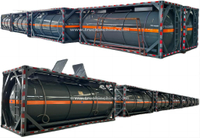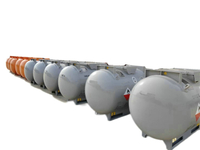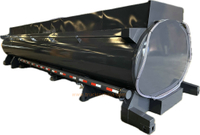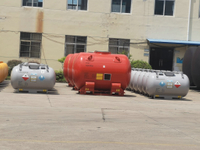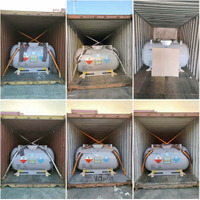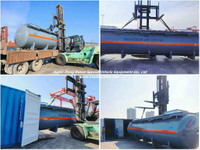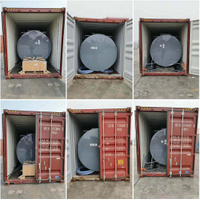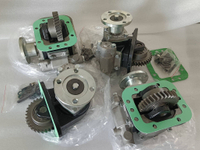Purity Aluminum 12mm 30ft HNO3 Container Tanks for Transport Nitric Acid 98% Concentration
Views: 2081 Author: Site Editor Publish Time: 2021-04-20 Origin: Site

Purity Aluminum 12mm 30ft HNO3 Container Tanks for Transport Nitric Acid 98% Concentration
TRANSPORTING NITRIC ACID ON ROADS
HAZARDS AND CLASSIFICATION OF NITRIC ACID
NITRIC ACID | Concentration < 70% | Concentration > 70% | Red Fuming |
Behaviour in case of release and mixture with air | · Corrosive
· Non combustible
· May cause fogging
· Oxidizer
· May cause fire on contact with combustible substances | · Corrosive · Non-combustible
· May cause fogging
· Strong oxidizer
· May cause fire on contact with combustible substances | · Very corrosive · Non-combustible
· Emits highly toxic vapours when exposed to air
· Very strong oxidizer releases oxygen
· Contact with combustible substances leads to immediate ignition |
Behaviour in case of release and mixture with water | · Dissolves fully in water with evolution of heat
· forms corrosive mixtures | · Dissolves fully in water with evolution of heat
· forms corrosive mixtures | · Dissolves fully in water with evolution of heat
· forms corrosive mixtures |
Health Hazard | · Skin contact leads to severe burns
· Vapours can cause severe acid burns to eyes, respiratory tract and lungs
· Delayed pulmonary oedema can be expected after vapour inhalation | · Skin contact leads to severe burns
· Vapours can cause severe acid burns to eyes, respiratory tract and lungs
· Delayed pulmonary oedema can be expected after vapour inhalation | · Skin contact leads to severe burns
· Vapours can cause severe acid burns to eyes, respiratory tract and lungs
· Delayed pulmonary oedema should be expected after vapour inhalation |
Transport classification IMDG | · UN 2031
· Label Class 8
· Packaging group II and specific requirements
· Stowage category D
· Segregation as for class 5.1 but "separated from" classes 4.1, 5.1 and 7 if concentration > 50% acid | · UN 2031
· Label Class 8
· Packaging group I and specific requirements
· Stowage category D
· Segregation as for class 5.1 but "separated from" classes 4.1, 5.1 and 7 | · UN 2032
· Label Class 8
· Subsidiary risk labels 5.1 and 6.1
· Packaging group I and specific requirements
· Stowage category D
Segregation as for class 5.1 but "separated from" classes 4.1, 5.1 and 7 |
Purity Aluminum 10mm Tank)
ISO 30ft Nitric Acid Tank ( HNO3 aluminium 30Feet Tank Container 81002 UN)( Chemical Storage or Road Transport Tank)
Container used for transportation of nitric acid concentration %98
· With volume 20-22 m3/container
· Complete of manhole, inlet, discharge pipes and all gauges
· The container complete with steel stand and support
Tank body is made of industrial high-purity aluminum thickness 12 mm and a discharge valve of C4
1. Bottom openings
Road tankers for transporting nitric acid with an acid content below 70% may have openings and valves below the level of the liquid. In this case, the haulier must demonstrate, prior to loading, that the tank material, the fittings and the seals meet the requirements for nitric acid duty (See Annex 2).
Road tankers with no openings and valves below the liquid level are preferred for transporting nitric acid with an acid content of 70% or more. However, there may be good reasons for using tanks with openings and valves below the liquid. For example, the consignee may use gravity for unloading. A special risk assessment must be carried out when a tank with openings and valves below the liquid level is used. In addition the following points must be followed:
• The haulier must check the maintenance of the valves on a regular basis and inform the producer of each check.
• The producer must check all closing devices for tightness. This applies in particular to the bottom and discharge valves.
2. Materials
Tanks to contain nitric acid below 70% concentration must be made of special steel which is resistant to nitric acid. Suitable materials include:




Warning! Materials DIN/EN 1.4301 or 1.4401 = UNS S 30400 or S 31600 (AISI 304 or
316) are not suitable for nitric acid tanks and should be avoided.
All hoses carried must be made from a material which is resistant to nitric acid. Suitable materials include polytetrafluoroethylene (PTFE) and polypropylene (PP), subject to the application (e.g. acid strangth, temperature, required service file). Hose
connections must also be compatible with nitric acid (e.g. stainless steels listed above).
Each road tanker must have written confirmation from the haulage company showing that the correct materials have been used for the tank and appendages, hoses, gaskets and bolts.
Pumps

3. Design and construction of tank containers
Isotanks may be used for transporting nitric acid by road, rail, sea or inland waterways. They must meet the requirements of the appropriate national or international provisions for design and construction, depending on the specific type of transport to be used. Material compatibility must be ensured by means of a suitable coating. The suitability of the tank container must be verified by comparison with the certificates issued by the responsible authority, or be confirmed by the owner prior to loading.
In addition to the requirements above, tank containers without openings below the liquid level are recommended for nitric acid with a concentration above 70%.
4. Design and construction of inland waterway tank vessels
Inland waterway tank vessels for transporting nitric acid on the Rhine or on German waterways are subject to the requirements and building regulations of the ADNR. In addition, the regulations of the Rhine Navigation Investigation Authority and the Rhine Navigation Police Authority must be complied with.
Waterway tank vessels conveying nitric acid must have been issued with an individual approval certificate. The approval certificate must confirm that the vessel has been examined and the construction and equipment are suitable for transporting nitric acid. The approval certificate is issued by the responsible authority of a Riparian State of the Rhine or of Belgium, based on an examination carried out by an expert nominated by the said authority. The responsible authority may waive a vessel examination if it is clear from the certificate of a recognised classification company that the construction and equipment comply with the regulations mentioned above.
5. PRODUCT TRAINING FOR DRIVERS OF ROAD TANKERS AND TANK CONTAINER VEHICLES AND FOR THE SHIPOWNER’S PERSONNEL
General training requirements for road tanker drivers
National and international regulations on transporting dangerous goods (for example ADR) stipulate that all drivers of road tankers or transport units transporting dangerous goods in permanently connected tanks, or attached tanks with a total volume of more than 3000 litres, must prove that they have taken part in a special training course for the transportation of dangerous goods in tanks. The ADR certificate is proof of participation in such a special training course and of having passed the examination set by the competent authority.
Specific requirements for nitric acid road tanker drivers
The dangerous properties of nitric acid are the corrosive hazards, the oxidizing effect and the release of hazardous fumes. The consignor should train the vehicle drivers employed on the hazards associated with nitric acid. Drivers of vehicles carrying dangerous goods in fixed or demountable tanks, with a total capacity exceeding 1000 litres and drivers of vehicles carrying dangerous goods in tank-containers with an individual capacity exceeding 3000 litres on a transport unit, shall hold a certificate issued by the competent authority.
The vehicle drivers must be familiar with the particular hazards associated with nitric acid and, from this knowledge, understand the recommended relief and safety measures to be taken in an emergency. Annex 3 includes recommendations on the content and scope of the training courses for vehicle drivers and how they should be carried out.
Drivers of vehicles carrying dangerous goods in fixed or demountable tanks, exceeding 1000 litres and drivers of vehicles carrying dangerous goods in tank-containers with an individual capacity exceeding 3000 litres on a transport unit, shall hold a certificate issued by the competent authority. The purchaser of a consignment of nitric acid transported by road tanker or tank container vehicle must require that the haulier use only vehicle drivers who have received special training for the transportation of nitric acid. The haulier must ensure that such vehicle drivers repeat the training course every two years and that they carry their training certificate with them when transporting nitric acid.
6. PROTECTIVE CLOTHING AND PERSONAL SAFETY EQUIPMENT
Technical and organisational methods should be taken which limit the direct handling of acid to that which is absolutely essential in order to protect employees handling nitric acid or highly concentrated nitric acid.
For example, product releases must be anticipated when transferring nitric acid (by ship, tank wagon or road tanker) or during work such as emptying or flushing hoses repair and reconstruction work, operating fittings and starting pumps.
The type and scope of protective clothing and personal safety equipment must be stipulated to correspond with the risk of possible release and depending on the concentration. Possible items of safety equipment are:
• full-body coverall (chemical coverall) or chemical protective suit
• sturdy shoes or acid-resistant boots
• closed protective glasses or visor with full mask
• helmet or helmet with neck guard
• acid-resistant protective gloves
The specific protective clothing and equipment to be used must be stipulated in substance-related and workplace-related company rules. For example, recommendations may be found in the safety data sheets.
Vehicle drivers who transport nitric acid by road must carry the protective equipment which is specified in the TREM card for road traffic, readily available in the vehicle. This also applies to the transport of empty tanks which last carried nitric acid and which have not yet been cleaned.
7. Tightness of the tanks
Close all the valves, openings and shut-off devices which are not needed for the filling operation, properly before filling. Take suitable measures (for example, extraction, gas displacement) during the loading of the tank with consignments of nitric acid to prevent the release of gases and vapours.
Check the tank and especially the rising pipe, for tightness during the filling operation.
Close all closure devices properly after filling so that none of the contents can leak out unnoticed. Close all openings and valves with protective caps and blind flanges wherever present. Replace missing nuts and bolts on all tank wagons, before transportation. Secure hand wheels or hand levers against unintentional opening.
Check all the closure devices including openings and valves not used during filling, for tightness. In particular, visually inspect the rising pipes, bottom and discharge valves for tightness.
Tanks containing nitric acid with a concentration above 99% must be inspected for tightness after filling or before transportation begins. After attaching the blind lids to the nozzles and fittings, apply compressed air at a pressure of at least 0.5 bar and at most 2 bar (preferably 1 bar). The apparatus for this purpose must be fitted with devices which permit the test pressure to be set, held and observed and which prevent the setting of any pressure above the permitted operating pressure (Figure 4).
Hold the test pressure for at least 15 minutes. Check all the flanges and fittings during this time. This can be done using a leak detector spray or ammonia gas (Figure 5). Ammonia gas is particularly suitable because it forms an ammonium nitrate mist which is easily visible with very small quantities of nitric acid vapours, thus detecting even the smallest leaks. Relieve the container to atmospheric pressure after the test. Extract and wash the pressure relief gas. If no leaks are detected, seal the pressure nozzle, after pressure relief and closure of the valve, with a blind lid with an exchangeable seal. If a leak is detected, relieve the container pressure as described, rectify the leak and carry out a second leak detection test.
There are various causes of leaks:
• missing seal
• incorrect seam
• defective seal
• bolts not tightened sufficiently
• damaged sealing surfaces
If the leak cannot be rectified for the reasons given above, empty the tank at the filling site, rinse and remove the cause of the leak.
UN No 2031
SUCCESS CASES
More >>- 2024-04-0910 Units T14 ISOTank Container For Hydrofluoric Acid Export to India
10 Units T14 ISOTank Container For Hydrofluoric Acid Export to India 20FT TANK CONTAINER (EMPTY AND NEW TANKS) 20 FT TANK CONTAINER FOR HYDROCHLORIC ACID UN1789 HCL, HYDROFLUORIC ACID UN1790 HF ACID CARON STEEL AND LINED WITH 16MM LLDPE TANKS CAPACITY 21 KL FOR ROAD INLAND MOVEMENTS
- 2023-12-226 pcs Metal Alky T21 UN3394 UN3399 Portable Tank TEAL DEAC MAO to SGP
6 pcs Metal Alky T21 UN3394 UN3399 Portable Tank TEAL DEAC MAO to SGP Max. gross weight : 4000 kg Tare : 1050 kg Payload : 2950 kg Portable Tank instruction : T21 ADR/RID tank code : N/A Special provisions : TP2 TP7 TP36 TP41 Model : KS1880-T21 ISO size/type code : N/A Type : UN Portable Tank Dimensions : 1148(E.D) x2128 (L) x1388 (H) mm Nominal capacity : 1880 L Measured capacity : 1880 L at 20°C Maximum allowable working pressure : 14 bar Test pressure : 21 bar APPROVALS ADR/RID: F/9151/BV/23 IMDG: F/BV/23/194-T21 US DOT: UN Portable Tank TIR*: GB/C 26839 BV/2023 SUBSTANCES SUITABLE FOR TRANSPORT: In accordance with the requirements of the applicable regulations and the construction of the tank and its equipment. (Substances not compatible with the tank and/or its accessories are excluded for transport) UN3394 & UN3399
- 2024-01-29Customized Hydrochloric Acid HCL Tank Container Lined PE 24m3 for Trailer Mounted to Vietnam
Customized Hydrochloric Acid HCL Tank Container Lined PE 24m3 for Trailer Mounted to Vietnam TANK CONTAINER VOLUME 24M3 STEEL SHEET 5MM, HEAD 6MM,Lined LLDPE 16mm for Hydrochloric Acid, Sulfuric Acid Transport 3 CHAMBERS HS CODE: 7309.00
- 2023-02-226 units Metal Alky C480 Portable Tank TEAL DEAC Cylinder for Singapore
6 units Metal Alky C480 Portable Tank TEAL DEAC Cylinder for Singapore 360 DEG. ROTATABLE TOP FLANGE VALVE (KV-MTFF DN15 PN 40), 360 DEG. ROTATABLE TOP FLANGE VALVE (KV-MTFE DN20 PN 40) K4430 Gaskets
- 2023-12-246 Units 40KL 44KL 40FT ISO Steel Lined PE Dilute Sulfuric Acid Tank Container To Kazakhstan
6 Units 40KL 44KL 40FT ISO Steel Lined PE dilute sulfuric acid Tank Container to Kazakhstan40FT Tank Container PE Lined TankUsed to contain: HCl (max 35%), NaOH (max 50%), PAC (max 17%),H2SO4(max 94%) etc…Sulphuric Acid Tank Capacity: 40,000 Liters;44,000 LitersSteel sheet 6mm, head 6mmLiner thickness: 16mm PE01p
- 2023-09-222 Sets HOWO Offroad AWD 6x6 Mixing And Charging ANFO Explosive Trucks Delivery
2 Sets HOWO Offroad AWD 6x6 Mixing And Charging ANFO Explosive Trucks Delivery
- 2023-09-1510 Units Hydrochloric Acid HCL PE LINED ISO Tank Containers to Vietnam
10 Units Hydrochloric Acid HCL PE LINED ISO Tank Containers to Vietnam 20FT Tank Container PE Lined Tank Used to contain: HCl (max 35%), NaOH (max 50%), PAC (max 17%),H2SO4(max 94%) etc… Tank Capacity: 21,900 Liters Steel sheet 6mm, head 6mm Liner thickness: 16mm PE
- 2023-08-1417m3 , 22m3 Lined PE Tank Container for Hydrochloric Acid HCL to Vietnam
17m3 , 22m3 Lined PE Tank Container for Hydrochloric Acid HCL to Vietnam 20FT TANK CONTAINER TANK VOLUME/ STEEL THICKNESS 22M3/ 6MM (SOC / EMPTY AND NEW TANKS) BRAND: DONG RUNZE MODEL: DRAU2308018 STORAGE TANK CONTAINER TANK FOR HCL CARGO TRUCK TANK VOLUME/STEEL THICKNESS:17M3/ 6MM ( EMPTY AND NEW TANKS) BRAND: DONG RUNZE MODEL: DTA5260 HS CODE : 7309000000
- 2023-07-104 Sets Polyethylene Lined Steel Offshore T14 Tanks For Hydrochloric Acid Transport to Kazakhstan
4 Sets Polyethylene Lined Steel Offshore T14 Tanks For Hydrochloric Acid Transport to Kazakhstan Marks DTAU2305012 DTAU2305028 DTAU2305033 DTAU2305049
- 2022-12-2780Units Metal Alky C480 UN Portable Tank T21 TEAL Cylinders to USA
80Units Metal Alky C480 UN Portable Tank T21 TEAL Cylinders to USA 80Units UN T21 Portable Tank Container 1880L Cylinder For TEAL Metal Alkyls UN3394 UN3399 to USA Adr/Rid Organometallic Substance, Liquid, Water- Reactive C-430 Saddle Type Portable Tank , tank capacity 1630L C-480 Saddle Type Portable Tank, tank capacity 1880L C-1980 TEAL TMGa ,TEGa,TMIn, TMAl DEAC Metal Alky C-1980 T21 Metal Alky 7495L
- 2023-04-056 Sets Polyethylene Lined Steel Tanks 6600Gallon For Hydrochloric Acid Storage Transport Hydrochloric Acid (HCl) to SAU Chemical Factory
6 Sets Polyethylene Lined Steel Tanks 6600Gallon For Hydrochloric Acid Storage Transport Hydrochloric Acid (HCl) to SAU Chemical Factory This the 4th LOT HCL ,NaCLO Tanks For this SAU Chemical Facttory . The 1 st Order date will go back to Date 13-1-2021. CAST IRON STORAGE TANK FOR CHEMICAL MATERIALS STORAGE TANK CAPACITY: 25M3 HS CODE:7309000000
- 2023-03-063 Sets Lined PE Tanks 6604Gallon For Storage Transport Sodium Hypochlorite to Saudi Arabia
3 Sets Lined PE Tanks 6604Gallon For Storage Transport Sodium Hypochlorite to Saudi Arabia FROM WUHAN PORT CHINA TO DAMMAM, SAUDI ARABIA BY SEA. + Port of loading : WUHAN PORT + Port of unloading :DAMMAM CAST IRON STORAGE TANK FOR CHEMICAL MATERIALS STORAGE TANK CAPACITY: 25M3 HS CODE:730900 10.2x2.1x2.5*3 160.65cbm 3X40HQ
- 2023-01-054PCS Power Take-off PTO FOR JMC TRANSMISSION MODEL DN3-7003-EC 6MT1420 to URUGUAY
4PCS Power Take-off PTO FOR JMC TRANSMISSION MODEL DN3-7003-EC 6MT1420 to URUGUAY Sdq51/65 (Gearbox Power Take off For ISUZU QINGLING Transmission DN3-70030-E0, 6MT1420 PTO Assembly) HWP-G32/65CHQ ,32/65 PQ1
- 2023-02-0812PCS PTO Wanliyang Transmission Power Take-off For WLY6T40 WLY6TS40 to Mexico
12PCS PTO Wanliyang Transmission Power Take-off For WLY6T40 WLY6TS40 to Mexico 1 PC SDQ211/60LGQ1 PTO FOR 6DS60T-D TO SAUDI ARABIA
- 2022-12-282 Units Righ Hand Drive Shacman F3000 Hydro Excavators Truck Combined Vacuum Sewer Jetting to Suva Port Fiji
2 Units Righ Hand Drive Shacman F3000 Hydro Excavators Truck Combined Vacuum Sewer Jetting to Suva Port Fiji Shacman F3000 Hydro Excavators Truck Sewer Jet Suction Units (RHD 13500L Sewage+4000L Clean Water ) PTO, transmission shaft, vacuum pump, tanker, hydraulic system and jetting pipe system. Combined Sewer Suction & Jetting Unit SZW Aluminium Alloy Liquid Water Ring Compressor Vacuum Pump XW-2800 VAC Flow 2800 M³/h ,1648 Cfm 46.7M3/min 75KW












